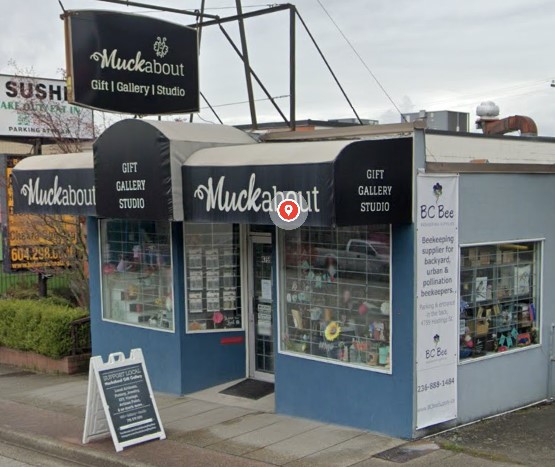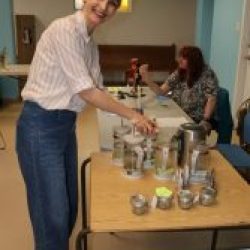Honeybees, Types of Honey, Beeswax and Other Products from the Hive by Winston Wong
It was very sweet (pun intended!) to have Winston Wong give a second presentation to our club, this time on “Honey bees, types of honey, beeswax and other products from the hive”. Winston is the owner of “BC Bee Supply” and his shop “The Honey Hub” is located in Burnaby.


Honey bees, Winston informed us, create many important products. Some of these are: honey, beeswax, royal jelly, propolis, bee pollen (bee bread), honeycomb, and bee venom. Winston brought a wide variety of “Honey Bee products” for us to examine!
We learned a bit about Honey bees themselves. Honey bees communicate by dance and it is often in the dark! There is only 1 queen but many female workers. The Queen can live 5 to 7 years but the workers only live 4 to 6 weeks. The male drones’ only function is to fertilize queens from different hives.
The Queen gives all the instructions and lays all the eggs. She can decide whether or not she lays fertilized eggs (which become drones). The workers collect all the food and they build and clean the hive. Those honeycomb hexagons are hung perfectly vertical. The Queen won’t lay eggs unless they are perfectly formed! Pollen, as well as royal jelly, goes into the cells along with the eggs.

The Honey bee body is statically charged so when they visit flowers, the whole body becomes covered in pollen. Workers bring in flower nectar (carbohydrates), pollen (protein), and water. It was fascinating to hear that the bees form a sort of assembly line, and along with the flower nectar, each worker bee passes along some of their unique enzymes to the next bee before the “house bees” deposit it in the cells. Nectar is sweet, but it has a high water content. The bees fan the cells in order to reduce the water. Eventually the bees deem that it is the right consistency and they cap off the cells. This is the point at which we would classify it as “honey” and it is only about 17% water. The low water content and the acidic nature of the honey is why it doesn’t spoil. Bacteria and moulds can’t survive.
Honey: Honey is known as a “perfect food” with no expiration date. Winston surprised us with the fact that preserved honey has even been found in Egyptian tombs! Some of its many uses are: medicinal, to soothe coughs, in cooking, as first aid, in soaps, in face scrubs, and as a sweetener. Creamed honey is spreadable as it is whipped. Winston mentioned that all honey will crystallize but it can be easily warmed and melted. Pasteurization will kill the healthy enzymes so Winston doesn’t sell pasteurized honey.


Beeswax: In the hive, beeswax forms the hexagonal comb which holds the pollen. We use beeswax for candles and when a beeswax candle is burned, it is thought to produce negative ions (no scientific proof though). Negative ions are purported to take stress away, such as when walking in the forest or beside the ocean. You can protect your wood with beeswax, waterproof your shoelaces or shoes, use it as a lip balm or as a base for cosmetics. When mixed with dammar resin, it is used for “encaustic wax art”!

Royal Jelly: This is a milky secretion from the worker-nurse bees. Every new bee gets a special diet which includes royal jelly at first, but those destined to become Queen Bees get a continuous supply. There are many claims that it might have significant benefits to humans.
Propolis: This is a resinous mixture of bee saliva, beeswax, and other substances such as tree sap. Bees use it to fill in small cracks in the hive that could cause wind drafts. It is anti-microbial and anti-bacterial and so is thought to have medicinal benefits for the immune system and for various disorders.
Bee Pollen: Also known as beebread, it is the primary protein food source for the hive. It is slightly fermented pollen and is thought to have powerful healing properties in humans.
Honeycomb: This is the holder for the honey and if you get a honeycomb full of honey, you can eat it. Most people chew the wax and spit it out.
Bee venom: There is specialized equipment to collect venom. A mild current causes the bee to eject her venom, but as she does not eject the stinger she does not die. Bee venom is purported to have pain relief qualities. It is also useful in reducing allergic reactions to bee stings.
Discussion and Questions:
Winston discussed the question of “Organic Honey” needing thousands of acres, and he said that there may be only one Canadian beekeeper who can rightfully claim this. Winston doesn’t believe this is a necessary factor in choosing your honey.
Honeybees that feed on sprayed blueberries are known to have higher mortality rates so beekeepers ask that the blueberry farmers spray only at night. These bees do still have a higher mortality rate, but if the bees increase overall production, there has to be some compromise here. As Winston notes, we are dependent on crops being pollinated and on cattle that eat pollinated plants. The reason Honey Bees are so important is that while other bees also pollinate crops, the Honey Bees can be controlled. They can be easily moved to different areas and also kept over the winter. Winston still feels that the best scenario is that we support all pollinators.
Winston was asked how he calculated how much honey to leave in the hive for the bees to survive over the winter. They can survive on sugar water but it’s not the best food. His simple guideline was that for 10 frames of bees, you should leave a box of 50 to 80 pounds. Winston leaves most of his honey for his own bees, as he sources it elsewhere.
In the winter, the hive needs to stay above 35+ degrees for the queen to survive. The worker bees stay around her and can live 4 to 5 months because they aren’t busy. (All the drones are sent out from the hive!) If the queen lives, she lays eggs in the next year. Queens go out to mate and become fertilized in the spring when they are only 1 to 2 weeks. The sperm is kept (inside her) for 5 to 7 years!
Treat time!
Winston brought a number of different types of honey as examples: Ginger, vanilla, chili pepper, smoked, fruit, royal jelly added, elderberry, buckwheat, chocolate. We chose four types for our tasting experience and it was amazing how honey could have such delicious flavours!
Winston invites you to visit his store, “The Honey Hub” (rear door entrance). Take some time to ALSO visit his wife Ninna’s “Muckabout” Gift and artisan store at the front!
Thank you so much, Winston, for returning as a “Part Two” to important pollinators! It was just as much fun (and more delicious!) as your presentation on Mason Bees last year. We hope to see you again next year for “Part Three”!!!
 Honey Hub is located at 4347 Hastings Street, Burnaby, BC and offers the most unique selection of honey in Western Canada.
Honey Hub is located at 4347 Hastings Street, Burnaby, BC and offers the most unique selection of honey in Western Canada.
https://bcbeesupply.com/collections/honey-hub-store-items
 BC Bee Supply is housed in the basement of 4759 Hastings Street, Burnaby, BC and is geared to new and returning beekeepers.
BC Bee Supply is housed in the basement of 4759 Hastings Street, Burnaby, BC and is geared to new and returning beekeepers.
www.BCBeeSupply.ca
 Muckabout Gift Gallery started in late 2016 and is a local artisan gift shop boasting over 100 artists and locally made beloved items, and several lines of art supplies to allow customers to DIY their own art. 4759 Hastings Street, Burnaby, BC.
Muckabout Gift Gallery started in late 2016 and is a local artisan gift shop boasting over 100 artists and locally made beloved items, and several lines of art supplies to allow customers to DIY their own art. 4759 Hastings Street, Burnaby, BC.
www.muckabout.ca

RELATED LINKS
Honeybee Research Center – HBR
“Since its establishment more than a century ago, the HBRC has been a leader in apiculture research primarily focused on honey bee health.”
https://hbrc.ca/
All About Bees
https://hbrc.ca/all-about-bees/
Creating a Bee-Friendly Garden
https://hbrc.ca/plants-for-bees/
Resources for Educators
https://hbrc.ca/new-resources-for-educators-2/
Resources for Beekeepers
https://hbrc.ca/resources-for-beekeepers/
Canada Action: 25 Facts about Honeybees
https://www.canadaaction.ca/canadian-honeybees-facts
Why Are Bees so Important: Twinkl (Student & Teacher Resources)
https://www.twinkl.ca/blog/why-are-bees-so-important
Canada Honey Council
https://honeycouncil.ca/
Canada Honey Council: Bee Facts
https://honeycouncil.ca/industry-overview/bee-facts/
 Previous Post
Previous Post Next Post
Next Post
Recent Comments